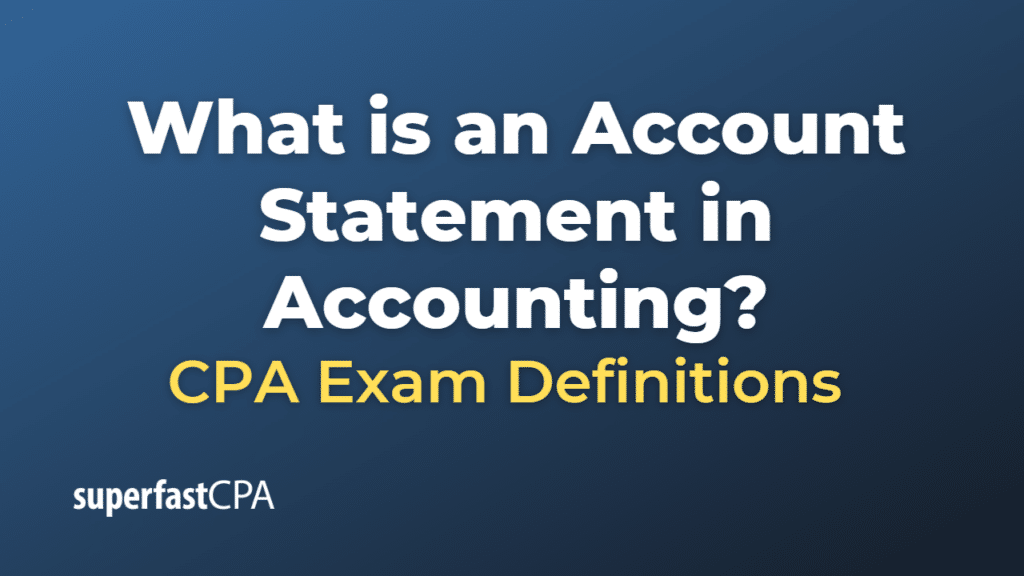What is an Account Statement in Accounting?
An account statement in accounting is a summary or report that provides information about the transactions and activity within a specific financial account over a certain period of time. Account statements are typically prepared and issued by financial institutions, such as banks and credit card companies, but can also be created internally by businesses for various accounts like accounts receivable or accounts payable. These statements are useful for tracking account activity, reconciling balances, and managing cash flows.
Common types of account statements include:
- Bank account statement: A bank account statement is a summary of all transactions, such as deposits, withdrawals, checks, and fees, that have occurred in a checking or savings account during a specific period. The statement usually includes the beginning balance, ending balance, and any interest earned.
- Credit card statement: A credit card statement is a summary of all transactions, such as purchases, payments, fees, and interest charges, that have occurred on a credit card account during a specific billing period. The statement typically includes the outstanding balance, minimum payment due, and the payment due date.
- Investment account statement: An investment account statement is a summary of all transactions, such as purchases, sales, dividends, and fees, related to an investment portfolio during a specific period. The statement usually includes the total value of the portfolio, as well as the performance of individual investments.
- Accounts receivable statement: An accounts receivable statement is a summary of all transactions, such as invoices, payments, and credit memos, related to a customer’s account during a specific period. The statement typically includes the outstanding balance and payment terms.
- Accounts payable statement: An accounts payable statement is a summary of all transactions, such as bills, payments, and debit memos, related to a vendor’s account during a specific period. The statement typically includes the outstanding balance and payment terms.
Account statements serve various purposes, such as:
- Providing a detailed record of account activity for individuals and businesses to review and verify transactions.
- Assisting in account reconciliation and ensuring the accuracy of financial records.
- Facilitating the management of cash flows and budgeting processes.
- Serving as documentation for tax, audit, and regulatory purposes.
Example of an Account Statement
Let’s look at an example of a simplified bank account statement for John Doe’s personal checking account for the month of January 2023.
John Doe
123 Main Street
Anytown, USA 12345
Checking Account Statement
Account Number: 123456789
Statement Period: January 1, 2023 – January 31, 2023
Beginning Balance (January 1, 2023): $5,000.00
| Date | Description | Debit | Credit | Balance |
|---|---|---|---|---|
| 01-05-2023 | Direct Deposit – Salary | $2,500.00 | $7,500.00 | |
| 01-08-2023 | ATM Withdrawal | $200.00 | $7,300.00 | |
| 01-10-2023 | Check #101 – Rent | $1,200.00 | $6,100 | |
| 01-15-2023 | Online Payment – Utilities | $150.00 | $5,950.00 | |
| 01-20-2023 | Grocery Store Purchase | $75.00 | $5,875.00 | |
| 01-25-2023 | Direct Deposit – Salary | $2,500.00 | $8,378.00 | |
| 01-30-2023 | Online Payment – Credit Card | $500.00 | $7,875.00 |
In this example, the bank account statement for John Doe’s checking account shows the beginning balance, all transactions that occurred during the statement period (January 1, 2023, to January 31, 2023), and the ending balance. The transactions include direct deposits, ATM withdrawals, checks, online payments, and a grocery store purchase.
John can use this account statement to review and verify his transactions, reconcile his account balance with his personal records, and manage his cash flows and budgeting. The statement also serves as documentation for tax and audit purposes, as well as for resolving any disputes or discrepancies with the bank.













